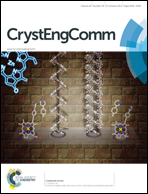Temperature-induced isosymmetric reversible structural phase transition in catena-[pyridinium tris(μ2-bromo)-cadmium(ii)]†
Abstract
A new centrosymmetric one-dimensional ABX3-type organic–inorganic hybrid polymer compound ([C5H6N+][CdBr3]−) was synthesized and separated into block colorless crystals. DSC and dielectric measurements indicate that this compound undergoes a reversible phase transition at 230 K with a hysteresis width of 17.9 K. The crystal structures, determined at 293(2) K and 140(2) K, show that the phase transition is a type of isosymmetric change from the space group of Pbca (no. 61) in the low-temperature phase (LTP) to the space group of Cmcm (no. 63) in the room-temperature phase (RTP). The main difference between the LTP and the RTP structures is the distribution of the nitrogen atoms in the pyridinium cations. In the LTP, pyridinium cations are well ordered with localized N and C atom positions. Meanwhile, for the RTP, the N atoms are indistinguishable from the C3 atoms with the occupancy of N/C3 atoms being 0.5, separately. Noncovalent static attracting forces (Coulombic and van der Waals forces) and nonclassical C–H⋯Br and N–H⋯Br hydrogen-bond interactions stabilize the crystal structure.
![Graphical abstract: Temperature-induced isosymmetric reversible structural phase transition in catena-[pyridinium tris(μ2-bromo)-cadmium(ii)]](/en/Image/Get?imageInfo.ImageType=GA&imageInfo.ImageIdentifier.ManuscriptID=C4CE00799A&imageInfo.ImageIdentifier.Year=2014)

 Please wait while we load your content...
Please wait while we load your content...